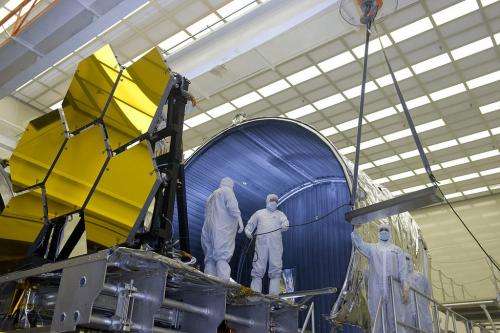James Webb space telescope's mirrors get 'shrouded'

(Phys.org) -- Earlier this year, NASA completed deep-freeze tests on the James Webb Space Telescope mirrors in a "shroud" at the X-ray & Cryogenic Facility (XRCF) at Marshall Space Flight Center in Huntsville, Ala.
All of the Webb's 18 main mirror segments were tested under conditions that they will experience when operating in space to verify they will work as expected. Tested in batches of six, the mirrors were transferred to the cryogenic testing chamber where they were plunged to a chilly -414 degrees Fahrenheit (-248 C). In the photo above, a batch of mirror segments sit on a stand that was placed inside a helium-cooled "shroud." The base of the shroud is visible in the lower left. The part that looks like a swing is a counterbalance weight for the crane that lifted the fully populated test stand into place.
"The large tube is the back of the helium shroud that will go around the mirrors and cool them," says Lee Feinberg, the NASA Optical Telescope Element Manager for the James Webb Space Telescope at the Goddard Space Flight Center in Greenbelt, Md., "The gaseous helium shroud sits inside of a liquid nitrogen shroud…which sits inside of a vacuum chamber. All three work together to create a vacuum and cold environment to test the mirrors."
That cold environment mimics the harsh cold of space. Once at sub-zero temperatures, the testing team measured the surface shape of the mirror segments to see how they performed at cryogenic temperatures. The team measured the mirror segments by using laser systems to illuminate them for reflection of the light back into a sensor. The sensor then measures the change in shape of the mirror as the temperature changes.
When fully deployed, the Webb's mirror will be over six times larger than that of the Hubble Space Telescope’s mirror. It's designed to look farther away and further back in time, and will be able to detect light from distant galaxies.
But despite Webb’s size, its segmented beryllium mirror technology is significantly lighter than Hubble’s one-piece glass mirror technology. Each of the 18 hexagonal, gold-coated primary mirror segments is hollowed out and ribbed on the backside, which Feinberg explains ”lightweights” them to reduce their mass while keeping their precise shape.
Provided by JPL/NASA




















